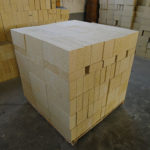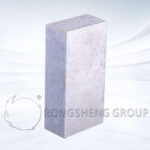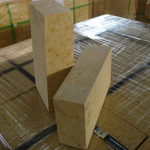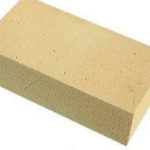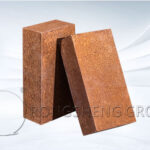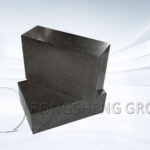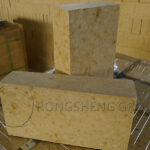High alumina refractory brick is an aluminum silicate refractory material with an alumina content of more than 55%. It is formed and calcined from alumina or other raw materials with high alumina content. It has high thermal stability and refractoriness above 1770℃. Good slag resistance. Rongsheng Refractory Bricks Manufacturer produces high-alumina mullite bricks and can customize appropriate specifications and sizes according to customer needs. It has customized refractory brick sizes.
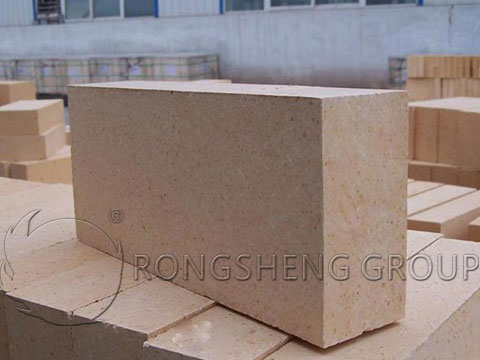
High Alumina Andalusite Bricks
- Material: high-quality bauxite and other raw materials
- Refractoriness: 1800℃
- Bulk Density: above 2.15g/cm3
- Compressive Strength: minimum 42MPA
What is the Use of Adding Andalusite to High Alumina Bricks?
Rongsheng refractory material manufacturer has many years of production and sales experience. Adding andalusite to high alumina bricks has the following main uses.
- Improve high-temperature performance. Andalusite has good high-temperature stability and thermal shock resistance. When andalusite is added to high alumina bricks, it can improve the high-temperature resistance of the high alumina bricks. The stable structure of andalusite can maintain the stability of its physical and chemical properties at high temperatures, allowing high alumina bricks to withstand higher temperatures.
- Improve fire resistance. Andalusite has a low thermal expansion coefficient and high thermal conductivity. This makes the high alumina bricks better resistant to temperature changes and thermal stress after adding andalusite. The high thermal conductivity of andalusite can help high-alumina bricks better disperse and conduct temperature, thereby reducing cracking and cracking caused by thermal stress.
- Enhance mechanical properties. Andalusite has high hardness and strength, and adding it to high alumina bricks can improve the overall mechanical properties. The high hardness and strength of andalusite help increase the compressive strength and wear resistance of high-alumina bricks. Making it more suitable for use in high-temperature and high-pressure environments.
- Promote mineral phase balance. The addition of andalusite can improve the mineral phase composition and structure of high alumina bricks. The aluminum and silicon elements in andalusite can react with the alumina and silicates in high-alumina bricks. The formation of a more stable mineral phase helps improve the crystal structure and thermal stability of high alumina bricks.
In general, the addition of andalusite to high alumina bricks can improve high-temperature performance, improve fire resistance, enhance mechanical properties and promote mineral phase balance. This enables high alumina bricks to better adapt to the requirements of high-temperature and high-pressure environments. It is widely used in high-temperature equipment and refractory components in metallurgy, glass, chemical, and other industries.
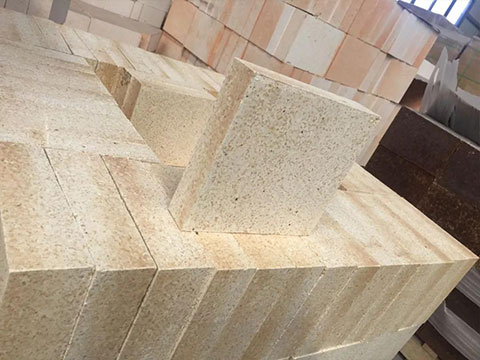
What is the Difference between Andalusite Mullite Bricks and Andalusite High Alumina Bricks?
Andalusite mullite bricks and andalusite high alumina bricks each have their own advantages. Although the main components of mullite bricks and high alumina bricks are alumina, their crystal phases are different.
When andalusite is heated to 1300°C, it turns into mullite, which is resistant to rapid cooling. It also has the advantages of strong impact resistance and high load conversion points. During the conversion process of mullite itself, the thermal expansion is low and the crystals are thicker. Andalusite does not need to be calcined and can be directly added to fired or unfired mullite bricks and high alumina bricks. Andalusite has the advantage of creep resistance. During use, impurities can cause premature softening of refractory bricks and have a great impact on creep. Therefore, a certain proportion of andalusite is added to mullite bricks or high alumina bricks. Make it resistant to high temperatures, rapid cooling, and rapid heating.
Andalusite high-alumina bricks are made of andalusite as the main raw material, adding bauxite, and are formed by high-pressure molding, drying, and firing at 1500°C. The characteristics of andalusite high alumina bricks are high-temperature resistance, high softening temperature under load, low creep rate at high temperatures, stable volume at high temperatures without volume, small thermal expansion coefficient and low thermal conductivity during use. Andalusite has a refractory degree of 1830°C and good chemical corrosion resistance. Adding andalusite to high-alumina refractory bricks can make the high-alumina bricks have wear resistance, higher load softening temperature, and better resistance to rapid cooling and heating. It can densify brick joints at high temperatures, improve the overall compactness of high-alumina brick masonry, and thereby improve slag permeability resistance.
Andalusite-mullite brick is a refractory brick made of andalusite and mullite in different proportions. This kind of brick has good oxidation resistance, strong fire resistance and high compressive strength. It also has the advantages of low specific gravity, good peel resistance, high-temperature flexural strength, and long service life.
In short, andalusite mullite and andalusite high alumina bricks have similarities but also big differences. Andalusite-mullite bricks are more expensive than andalusite high-alumina bricks, while andalusite high-alumina bricks have strong high-temperature corrosion resistance. Andalusite-mullite bricks have good flexibility and stronger resistance to peeling.
To purchase high-quality high-alumina bricks, mullite bricks, andalusite bricks, high-alumina andalusite bricks, andalusite-mullite bricks, please choose Rongsheng Refractory Bricks Manufacturer. Professional technical team, customized refractory brick lining solutions. Competitive price. Long life and efficient use. Contact us to get free samples and quotes.

